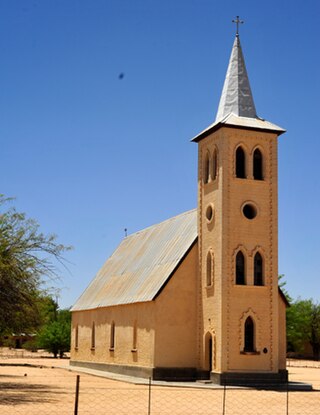
Karibib is a town in the Erongo Region of western Namibia. It has 3,800 inhabitants and owns 97 square kilometres (37 sq mi) of town land. Karibib is the district capital of the Karibib electoral constituency. It is situated on the Khan River, halfway between Windhoek and Swakopmund on the B2, the main road between Walvis Bay and Johannesburg. The town is known for its aragonite marble quarries and the Navachab Gold Mine.

Otjimbingwe is a settlement in the Erongo Region of central Namibia. Otjimbingwe has approximately 8,000 inhabitants and belongs to the Karibib electoral constituency.
Trekkopje is a mountain in the Erongo Region of Namibia, c. 85 kilometres (53 mi) north-east of Swakopmund on the road to Usakos.
The Trans-Kalahari Corridor is a paved highway corridor that provides a direct route from the port of Walvis Bay and Windhoek in central Namibia, through Botswana, to Pretoria in Gauteng province in South Africa. It initially cost approximately 850 million Namibian dollars and was officially opened in 1998.

TransNamib Holdings Limited, commonly referred to as TransNamib, is a state-owned railway company in Namibia. Organised as a holding company, it provides both rail and road freight services, as well as passenger rail services. Its headquarters are in the country’s capital Windhoek.

Windhoek railway station is a railway station serving the city of Windhoek, the capital of Namibia. It is an important station in the Namibian rail network, and it is run by TransNamib.

Okahandja railway station is a railway station serving the town of Okahandja in Namibia. It is part of the TransNamib Railway.

Swakopmund railway station is a railway station serving the town of Swakopmund in Namibia. It is part of the TransNamib railway network. Its IATA code is ZSZ.

Walvis Bay railway station is a railway station serving the port city of Walvis Bay in Namibia. It is part of the TransNamib railway network.

Keetmanshoop railway station is a railway station serving the town of Keetmanshoop in Namibia. It was erected in 1908. when the territory was colonised by Imperial Germany. It is part of the TransNamib Railway, and is located along the Windhoek to Upington line that was inaugurated in 1915 and connects Namibia with South Africa. Keetmanshoop also has a junction to Seeheim and Aus, completed in 1908.

Kranzberg railway station is a railway station in Namibia between the towns of Karibib and Usakos. It is part of the TransNamib Railway. At Kranzberg, the railway line from Windhoek splits; one line continues westwards to Swakopmund and Walvis Bay, the other one continues north-eastwards towards Omaruru and Tsumeb.

The South West African Zwillinge 0-6-0T of 1898 was a narrow gauge steam locomotive from the German South West Africa era.
Gross Barmen is a historic settlement and a recreational spa on the Swakop River in central Namibia, north of Windhoek. It is situated on the District Road 1972, 25 km south-west of Okahandja in the Otjozondjupa Region. Its close proximity to the capital Windhoek makes it a popular weekend destination for locals.

The rail service in Namibia is provided by TransNamib. The Namibian rail network consists of 2,687 km of tracks (2017).

Franz Heinrich Kleinschmidt (1812–1864) was a German missionary and linguist who worked in southern Africa, now in the region of Namibia. He founded the missionary station and town of Rehoboth and together with Carl Hugo Hahn set up the first Rhenish mission station to the Herero people in Gross Barmen. Kleinschmidt is known for his scientific work on the Nama language.

The history of rail transport in Namibia began with a small mining rail line at Cape Cross in 1895. The first major railway project was started in 1897 when the German Colonial Authority built the 600 mm gauge Staatsbahn from Swakopmund to Windhoek. By 1902 the line was completed.

Usakos railway station is a railway station in Namibia serving the city of Usakos. It is part of the TransNamib railway network. The station building is dilapidated but passenger trains still stop at Usakos.

The South West African 2-8-0T of 1907 was a steam locomotive from the German South West Africa era.
The Swakopmund–Windhoek line was a main 600 mm narrow-gauge railway line in Namibia. It was built in 1897 and operated until 1990 when the route name was changed.

Abbabis is a disused railway station southwest of Karibib in the Erongo Region of western Namibia on the 600 mm dismantled narrow gauge Swakopmund–Windhoek railway line established in 1900. When this line was converted to 1,067 mm from 1910 onwards, it lo longer passed Abbabis.

















